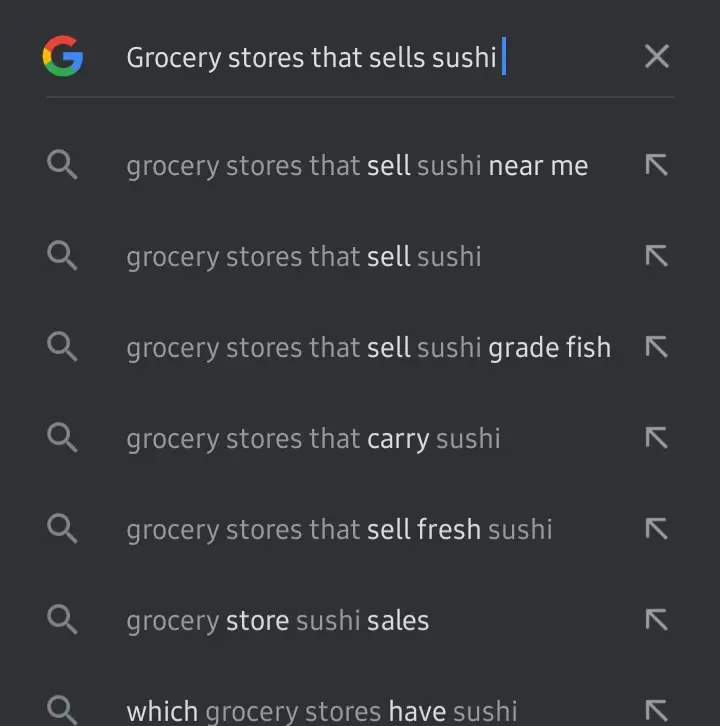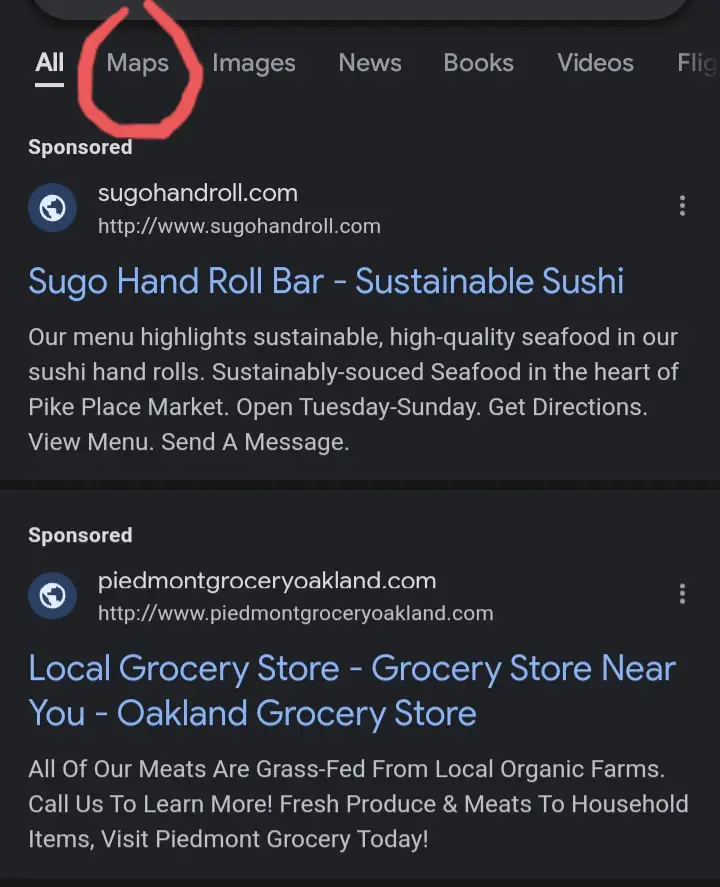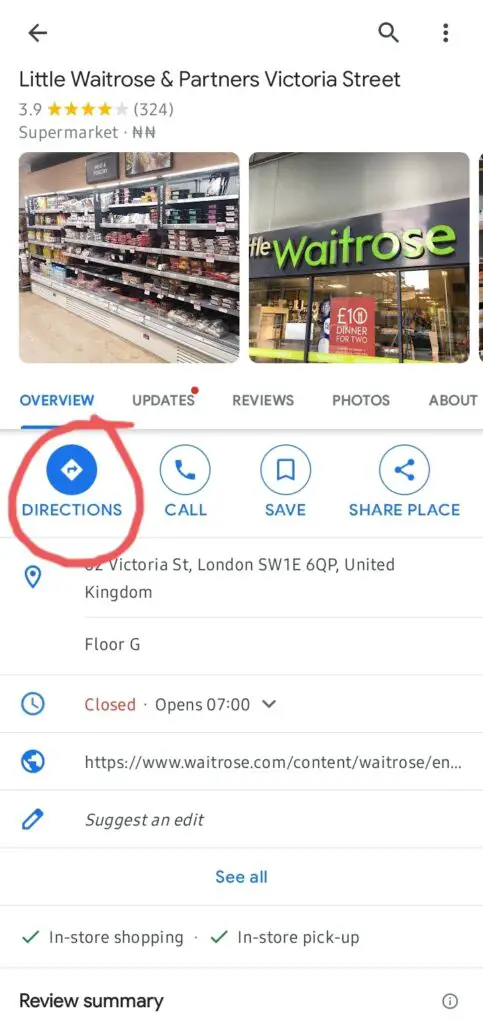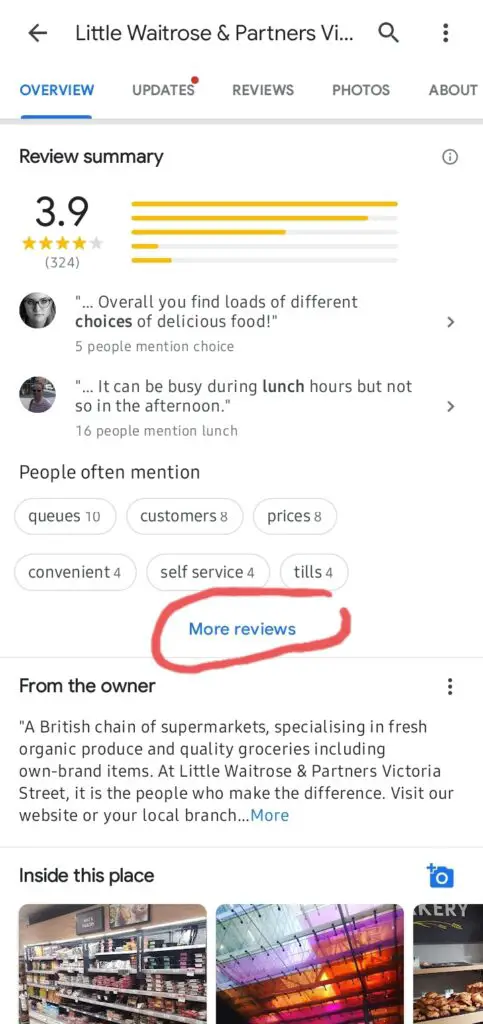An estimated 3,000 sushi restaurants in the United States serve at least $1 billion in sushi each year. Finding a grocery store that sells this Japanese food should not be a problem. You only have to keep your fingers crossed and hope you find a good place to buy healthy sushi.
We’ll be giving you a guide below on how you can locate the nearest grocery store that sells sushi.
- Open your preferred browser and search for, “grocery stores that sells sushi near me.”

- Tap on Maps

- Scroll through the stores you find and tap on any one you prefer.
- Tap on directions and scroll through the profile of the store to see photos and ways to contact them.

- You can also read the reviews from other visitors to get an idea of their customer service quality.

Make sure you confirm their opening and closing hours before heading out. Now you can go ahead and visit the store.
Is sushi bought in grocery stores better?
In this busy world and age, instead of spending time at the grocery store and heading over to the restaurant to buy prepared food, why not purchase it at the grocery store since they also sell it?
There is a big difference between the sushi you purchase at the grocery store and one that was prepared by a serious chef at a restaurant. Here are some of the differences we have observed.
- The temperature and flavor of the rice are not standard. The rice is not cooked to the right flavor and texture, and it is usually served when already cold.
- The fish is usually over-frozen before being used. This makes it lose its flavor. The seasonings used are also not regular.
- The seaweed gets soft over time.
- Pickled ginger is the best to use for sushi. Serious chefs produce their own pickled ginger in mass. This makes it taste sweeter when compared to a grocery store.
- The wasabi used in sushi loses its taste.
- A sushi chef uses his own custom soy sauce, while in a grocery store, they use any product of soy sauce that they want.
In some grocery stores, the sushi is not prepared by professionals. If you still want to get your sushi from them, don’t expect anything extravagant.
What do I eat with sushi?
Make sure you have side dishes and condiments to complement your sushi when you next buy it. We’ll be listing some drinks, desserts and side food you can eat with sushi below;
Side food to eat with sushi;
- Seaweed Salad
- Wasabi
- Harumaki
- Miss soup
- Soy sauce
- Kamikaze imitation crab meat
- Tempura
- Pickled ginger
- Gyoza Japanese dumplings
- Tamagoyaki
- Steamed edamame
Some deserts and drinks you can use with sushi includes;
- Strawberry mochi
- Matcha ice cream
- Green tea
- Tamagoyaki
These side dishes and beverages are mostly consumed and enjoyed by Japanese people. You can also try them out or find another side dish suitable for you.
Will I get sick from eating sushi?
Before you think of heading to your kitchen to prepare sushi, make sure you are properly trained and you have examined, bought, and handled the fish carefully to reduce the risk of parasites and illness. This is why a Japanese sushi chef must be licensed (although it is not a law in the United states)
The most common illness gotten from the consumption of sushi is anisakiasis. It is obtained from consuming an infected fish. The main cause is a parasitic worm that attaches itself to your intestine, esophagus, or stomach, leading to food poisoning.
Another common disease is listeria. It is obtained from the consumption of smoked seafood and sushi. The recommended way to avoid these diseases is to stay away from raw or undercooked seafood.
How do you not get sick from sushi?
If you are a lover of the Japanese cuisine called sushi, you should know it is irresistible. However, it comes with some health risks, like salmonella, tapeworms, and listeria. It is made with raw fish and can be very problematic, but should you stop eating it? No!
You should simply do the following things to avoid getting ill from eating what you enjoy.
Avoid eating sushi at just any restaurant.
Only visit those restaurants that have well-trained sushi chefs and staff. When a chef knows his/her job, they can easily detect when a raw fish has the anisakis larvae. Eating at cheap sushi restaurants may not help you here.
A professional sushi chef should know how to prevent infections and parasites. The fish should be frozen at -4°F for at least one week.
Don’t try making your own sushi at home. This could have been safer since you got to know what is safe for your health, right?
Even though you were taught how to prepare sushi and fish, there are some limiting factors that make it unsafe. Firstly, your home freezer won’t freeze the fish properly to get rid of the parasite. The fish you also get from the supermarket is not frozen properly and is not for sushi.
Make sure you are picking the right fish. Some fish, including perch, Brook trout, and pike, are freshwater and are a big no-no for sushi or consuming raw. Before eating, they should have been prepared with a degree of 145 Fahrenheit
Tuna is one fish that is highly recommended for sushi. Although it still gets contaminated, it’s the safest option.
Pregnant women and other people with weak immune systems should totally avoid the consumption of sushi. You do not want your body system to undergo the sushi experiment and break down every time you try a bad one.
Can you buy sushi and eat it the next day?
Seafood and raw fish have a very high tendency to be infected with communicable bacteria and parasites. In the cases of older adults, children, people with chronic health issues, and pregnant women, food poisoning may be very serious. Sushi is one food that you do not want to get contaminated by.
Buying and eating your sushi the next day is not the problem. It becomes an issue when you do not preserve it properly. Raw foods should be wrapped with foil, moisture-proof paper or plastic wrap and kept in the refrigerator.
Cooked and raw sushi can be refrigerated for up to 4 and 2 days, respectively. It can also be frozen and kept at a constant temperature for a longer period, but the quality of your sushi will not be the same.
How do I know if my sushi is bad?
Using your sense organs (the eyes, nose, and skin) to recognize spoiled sushi is not very special and hard. You simply have to use the methods you use for other foods.
Below are ways you can easily spot the signs of spoiled food.
- Sushi becomes dull and less attractive. Don’t get confused with the slight changes in texture and taste refrigerating a sushi gives and the looks of a spoiled one. A sushi will change in color and even begin to form a mold.
- Check the food for slime. When most foods are bad, they become slimy. If you try to separate a little piece of rice in the sushi and also see a slice, do not eat it.
- Perceive the sushi. Bacteria in raw food may cause the emission of a very bad odor when spoiled. Even if it has been stored in a refrigerator, always check for odor. Discard any sushi that has developed a bad odor after being stored in a freezer or refrigerator.
The best time to eat sushi and enjoy it warm and fresh is a maximum of 2 hours. Your sushi will get bad when you do not store it properly or overstore it for a long time. To reduce the rate of bacterial growth and moisture, you can store sushi in an airtight and properly sealed container.
How do I eat sushi with a chopstick?
Using chopsticks to eat sushi requires another level of skill and practice. A chopstick is merely an extension of the index and thumb fingers for people that have mastered its use. As a beginner, here are some tips that you need.
Do this with a chopstick:
Lightly use the chopstick to lift the sushi and dip the fish (not rice) into the soy sauce. Open your mouth and put the whole sushi in it. When the chopstick is not in use, place it on the ceramic holder. The blunt end is what is used in picking food from the plate.
Do not do these while eating sushi with a chopstick:
Do not rub the chopsticks together. The wasabi should not be put in the soy sauce. If you must add some more wasabi, put it on the sushi. Do not pick up and drop the sushi when you are not ready to eat it.
